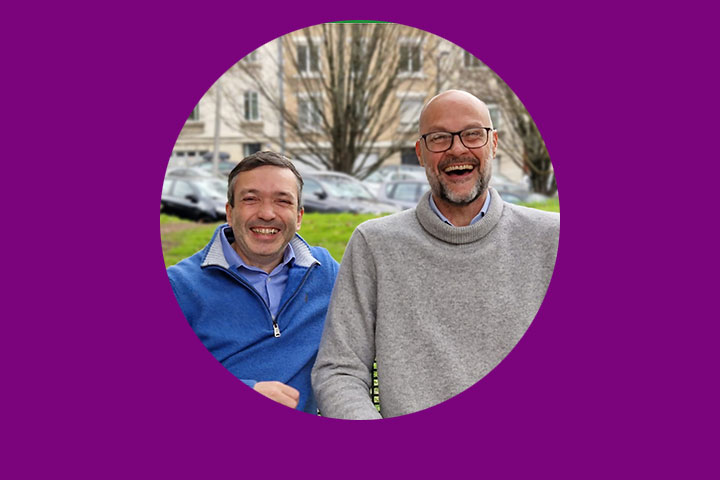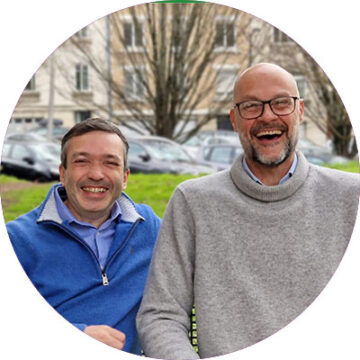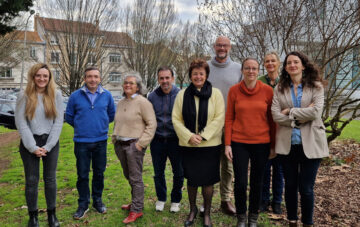
Three questions to Giovanni Stevanin and Cyril Goizet
 In January 2022, INCIA welcomed a new team: “Translational Research on Neurogenetic Diseases (NRGEN)”, dedicated to the improvement of knowledge in hereditary forms of neurodegenerative diseases. Giovanni Stevanin and Cyril Goizet are in charge of it.
In January 2022, INCIA welcomed a new team: “Translational Research on Neurogenetic Diseases (NRGEN)”, dedicated to the improvement of knowledge in hereditary forms of neurodegenerative diseases. Giovanni Stevanin and Cyril Goizet are in charge of it.
Bordeaux Neurocampus : Can you explain your field of study?
Cyril Goizet and Giovanni Stevanin: At the interface between neuroscience, neurology and human genetics, the team brings together researchers mainly, but not exclusively, interested in a continuum of overlapping neurogenetic disorders, covering spinocerebellar degenerations (ataxias, spastic paraplegias), motor neuron diseases (amyotrophic lateral sclerosis, hereditary spastic paraplegias, neuropathies) and neurodegenerations with iron accumulation in the brain. Our goal is to dissect the molecular basis of these neurogenetic diseases with the aim of developing specific therapies, which are lacking for almost all of them. In the past, we have identified about twenty genes responsible for these diseases and contributed to studies on about forty of them.
What is the strength of this team?
 Our main strength lies in its complementarity. Our skills cover the clinical field with Cyril Goizet, genetics and modelling in mice with Giovanni Stevanin, modelling in yeast and biochemistry with Jean-Paul Lasserre, and in vitro cell modelling with Isabelle Coupry and Christelle Durand. We use a combination of tools to improve diagnostic capabilities in these diseases (fight against diagnostic erraticity) including genetic analyses (exome, genome, detection of repeat expansions) to better characterise the clinical and mutational spectra and establish phenotype-genotype correlations while studying their genomic supports. We also seek to better understand their pathophysiological basis via functional analyses (cell, yeast and mouse models), which will also allow us to search for biomarkers and new specific therapeutic targets.
Our main strength lies in its complementarity. Our skills cover the clinical field with Cyril Goizet, genetics and modelling in mice with Giovanni Stevanin, modelling in yeast and biochemistry with Jean-Paul Lasserre, and in vitro cell modelling with Isabelle Coupry and Christelle Durand. We use a combination of tools to improve diagnostic capabilities in these diseases (fight against diagnostic erraticity) including genetic analyses (exome, genome, detection of repeat expansions) to better characterise the clinical and mutational spectra and establish phenotype-genotype correlations while studying their genomic supports. We also seek to better understand their pathophysiological basis via functional analyses (cell, yeast and mouse models), which will also allow us to search for biomarkers and new specific therapeutic targets.
Our approaches thus aim to improve patient care. For example, we specialise in the high-throughput sequencing of “Long fragments”, i.e. full-length DNA or RNA molecules, in order to facilitate the genetic diagnosis of nucleotide repeats with the reference centre directed by Cyril Goizet. In addition, we are looking for new genes involved. Today, there is a diagnostic ‘bottleneck’, and we need to look at non-coding regions of the genome and search for other types of mutations such as nucleotide repeat amplifications. The use of long fragment sequencing technology is a growing approach for these applications.
What does being part of Bordeaux Neurocampus bring to you?
Being part of the INCIA has several advantages. Hereditary neurodegenerative diseases are characterised by cognitive and motor impairments, which are INCIA’s research themes. In addition, the Institute has a platform dedicated to movement, the PAM. We will be able to analyse in detail the motor impacts of the neurogenetic diseases studied. In addition, we are already collaborating with the department, in particular with the IINS, on a new causal gene that we recently identified, to help us understand the biological effects of the variants.
In addition, we are strengthening neurogenetics at Bordeaux Neurocampus, a discipline that has been poorly represented until now. We are enriching the department’s field of competence through an approach to identify genetic forms in humans and modelling in animals to identify molecules of therapeutic interest, with a focus on ataxias, spinocerebellar degenerations and neurodegenerations with iron accumulation in the brain. The yeast model mastered by the team is a valuable asset for screening molecules of therapeutic interest. Of course, we can adapt this method to other diseases. We are neurogeneticists who are very open to collaborations.
Finally, we wish to invest in training by creating a national neurogenetics diploma open to clinicians and researchers and a technical training course at bachelor level to train assistant engineers in the scientific approach on the model of the biomedical research bachelor’s degree created 10 years ago in Paris (ESTBA).
More details
Giovanni Stevanin :
- “Directeur de recherche” – Inserm
- “Directeur d’études cumulant” – EPHE/Université PSL
- Since 2019: Team leader at ICM (Team “Neurogénétique fondamentale et translationnelle”)
Cyril Goizet :
- PU-PH – CHU de Bordeaux, service de génétique médicale
- Leader of the “Centre de référence de Neurogénétique”
Last update 16/02/23
